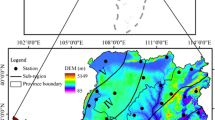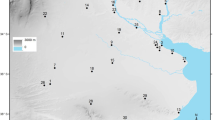Abstract
Evapotranspiration is a critical hydrological and meteorological variable impacted by climate change. In this study, the annual potential evapotranspiration (ETo) was estimated using the Penman-Montieth method at 104 meteorological stations in Inner Mongolia, China, from 1971 to 2016. The characteristics of seasonal and annual ETo were analyzed using the least squares method and trends of ETo, and its driving meteorological factors were investigated using the Mann-Kendall test. The most influential meteorological factors driving ETo were identified using stepwise regression and partial correlation analysis. Results showed that the annual average (range) ETo was approximately 1050 mm (996–1165 mm), and air temperature was approximately 4 °C (3.25–6.01 °C). ETo decreased over time, suggesting that the evaporation paradox exists. The ETo in summer was the largest followed by that in spring, autumn, and winter. Relative humidity, precipitation, sunshine duration, minimum temperature, maximum temperature, and mean temperature were the main factors influencing the distribution of ETo. Trends of ETo showed a high degree of spatial variability; however, stations showing significant negative trends were generally concentrated in central Inner Mongolia. At an annual time scale, decreased wind speed and sunshine duration were the most important drivers of reduced ETo.







Similar content being viewed by others
References
Allen R G, Pereira L S, Raes D et al (1998) Crop evapotranspiration-Guidelines for computing crop water requirements-FAO Irrigation and drainage paper 56 [J]. FAO, Rome, 300(9):D05109. https://www.researchgate.net/publication/235704197
Bandyopadhyay A, Bhadra A, Raghuwanshi NS, Singh R (2009) Temporal trends in estimates of reference evapotranspiration over India. J Hydrol Eng 14(5):508–515. https://doi.org/10.1061/(ASCE)HE.1943-5584.0000006
Breña-Naranjo JA, Laverde-Barajas MÁ, Pedrozo-Acuña A (2017) Changes in pan evaporation in Mexico from 1961 to 2010 [J]. Int J Climatol 37(1):204–213. https://doi.org/10.1002/joc.4698
Brutsaert W, Parlange MB (1998) Hydrologic cycle explains the evaporation paradox [J]. Nature 396(6706):30. https://doi.org/10.1038/23845
Cohen S, Ianetz A, Stanhill G (2002) Evaporative climate change at Bet Dagan, Israel, 1964–1998. Agric For Meteorol 111:83–91. https://doi.org/10.1016/S0168-1923(02)00016-3
Cong Z, Ni G, Yang D et al (2008) Evaporation paradox in China. Adv Water Sci 19(2):147. https://doi.org/10.14042/j.cnki.32.1309.2008.02.001
Dinpashoh Y, Jhajharia D, Fakheri-Fard A et al (2011) Trends in reference crop evapotranspiration over Iran [J]. J Hydrol 399(3):422–433. https://doi.org/10.1016/j.jhydrol.2011.01.021
Donohue RJ, McVicar TR, Roderick ML (2010) Assessing the ability of potential evaporation formulations to capture the dynamics in evaporative demand within a changing climate [J]. J Hydrol 386(1–4):186–197. https://doi.org/10.1016/j.jhydrol.2010.03.020
Duhan D, Pandey A, Pandey RP (2013) Analysing trends in reference evapotranspiration and weather variables in the tons river basin in Central India. Stoch Env Res Risk A 27(6):1407–1421. https://doi.org/10.1007/s00477-012-0677-7
Exner-Kittridge MG, Rains MC (2010) Case study on the accuracy and cost/effectiveness in simulating reference evapotranspiration in West-Central Florida. J Hydrol Eng 15:696–703. https://doi.org/10.1061/(ASCE)HE.1943-5584.0000239
Feng G, Cobb S, Abdo Z et al (2016) Trend analysis and forecast of precipitation, reference evapotranspiration, and rainfall deficit in the Blackland Prairie of Eastern Mississippi [J]. J Appl Meteorol Climatol 55(7):1425–1439. https://doi.org/10.1175/JAMC-D-15-0265.1
Fermor P, Hedges P, Gilbert J, Gowing D (2001) Reedbed evapotranspiration rates in England. Hydrol Process 15:621–631. https://doi.org/10.1002/hyp.174
Gao G, Chen D, Ren GY, Chen Y, Liao YM (2006) Spatial and temporal variations and controlling factors of potential evapotranspiration in China:1956–2000 [J]. Geogr Sci 16(1):3–12. https://doi.org/10.1007/s11442-006-0101-7
Gao Z, He J, Dong K et al (2017) Trends in reference evapotranspiration and their causative factors in the West Liao River basin, China [J]. Agric For Meteorol 232:106–117. https://doi.org/10.1016/j.agrformet.2016.08.006
Gavin H, Agnew C (2004) Modelling actual, reference and equilibrium evaporation from a temperate wet grassland. Hydrol Process 18:229–246. https://doi.org/10.1002/hyp.1372
Han S, Wang S, Yang D (2010) Agricultural influences on evaporation paradox in China [J]. Trans Chin Soc Agric Eng 26(10):1–8. https://doi.org/10.3969/j.issn.1002-6819.2010.10.001
Hisdal H, Stahl K, Tallaksen L M et al (2001) Have streamflow droughts in Europe become more severe or frequent? [J]. Int J Climatol 21(3):317–333. https://doi.org/10.1002/joc.619
Huang H, Han Y, Cao M et al (2015) Spatiotemporal characteristics of evapotranspiration paradox and impact factors in China in the period of 1960–2013 [J]. Adv Meteorol. https://doi.org/10.1155/2015/519207
IPCC (2007) Climate change 2007: the physical science basis. In: Contribution of working group 1 to the fourth assessment report of the intergovernmental panel on climate change. Cambridge University Press, Cambridge and New York
IPCC (2014) Climate change 2013: the physical science basis. Contribution of working group I to the fifth assessment report of the intergovernmental panel on climate change [M]. Cambridge University Press, Cambridge and New York, pp 2–34
Jhajharia D, Shrivastava SK, Sarkar D et al (2009) Temporal characteristics of pan evaporation trends under the humid conditions of northeast India [J]. Agr Forest Meteorol 149(5):763–770. https://doi.org/10.1016/j.agrformet.2008.10.024
Jhajharia D, Kumar R, Choudhary RR (2014) Searching evidence for the existence of evaporation paradox in arid environments of northwest India [J]. Global NEST J 16:1–9
Jovanovic B, Jones DA, Collins D (2008) A high-quality monthly pan evaporation dataset for Australia. Clim Chang 87:517–535. https://doi.org/10.1007/s10584-007-9324-6
Li QX, Dong WJ, Li W, Gao X, Jones P, Kennedy J, Parker D (2010) Assessment of the uncertain ties in temperature change in China during the last century. Chin Sci Bull 55(19):1974–1982. https://doi.org/10.1007/s11434-010-3209-1
Li Z, Zheng FL, Liu WZ (2012) Spatiotemporal characteristics of reference evapotranspiration during 1961–2009 and its projected changes during 2011–2099 on the loess plateau of China [J]. Agric For Meteorol 154:147–155. https://doi.org/10.1016/j.agrformet.2011.10.019
Liang L, Li L, Liu Q (2011) Spatio-temporal variations of reference crop evapotranspiration and pan evaporation in the West Songnen Plain of China [J]. Hydrol Sci J 56(7):1300–1313. https://doi.org/10.1080/02626667.2011.609484
Limjirakan S, Limsakul A (2012) Trends in Thailand pan evaporation from 1970 to 2007 [J]. Atmos Res 108:122–127. https://doi.org/10.1016/j.atmosres.2012.01.010
Liu B, Xu M, Henderson M et al (2004) A spatial analysis of pan evaporation trends in China, 1955–2000 [J]. J Geophys Res Atmos 109(D15). https://doi.org/10.1029/2004JD004511
Lu X, Bai H, Mu X (2016) Explaining the evaporation paradox in Jiangxi Province of China: spatial distribution and temporal trends in potential evapotranspiration of Jiangxi Province from 1961 to 2013 [J]. Int Soil Water Conserv Res 4(1):45–51. https://doi.org/10.1016/j.iswcr.2016.02.004
Ma X, Zhang M et al (2012) Decreasing potential evapotranspiration in the Huanghe River watershed in climate warming during 1960-2010 [J]. J Geogr Sci 22(6):977–988. https://doi.org/10.1007/s11442-012-0977-3
Mallikarjuna P, Jyothy SA, Murthy DS, Reddy KC (2014) Performance of recalibrated equations for the estimation of daily reference evapotranspiration. Water Resour Manag 28:4513–4535. https://doi.org/10.1007/s11269-014-0733-9
Mann HB (1945) Nonparametric tests against trend [J]. Econometrica J Econometric Soc:245–259. http://www.jstor.org/stable/1907187
Oguntunde PG, Abiodun BJ, Olukunle OJ et al (2012) Trends and variability in pan evaporation and other climatic variables at Ibadan, Nigeria, 1973–2008 [J]. Meteorol Appl 19(4):464–472. https://doi.org/10.1002/met.281
Rayner DP (2007) Wind run changes: the dominant factor affecting pan evaporation trends in Australia [J]. J Clim 20(14):3379–3394. https://doi.org/10.1175/JCLI4181.1
Ren J, Li Q, Yu M, Li H (2012) Variation trends of meteorological variables and their impacts on potential evaporation in Hailar region [J]. Water Sci Eng 5(2):137–144. https://doi.org/10.3882/j.issn.1674-2370.2012.02.002
Roderick ML, Farquhar GD (2002) The cause of decreased pan evaporation over the past 50 years [J]. Science 298(5597):1410–1411. http://www.jstor.org/stable/3832789
Shan N, Shi Z, Yang X et al (2015) Spatiotemporal trends of reference evapotranspiration and its driving factors in the Beijing-Tianjin sand source control project region, China [J]. Agric For Meteorol 200:322–333. https://doi.org/10.1016/j.agrformet.2014.10.008
Song ZW, Zhang HL, Snyder RL et al (2010) Distribution and trends in reference evapotranspiration in the North China plain [J]. J Irrig Drain Eng 136(4):240–247. https://doi.org/10.1061/(ASCE)IR.1943-4774.0000175
Tabari H (2010) Evaluation of reference crop evapotranspiration equations invarious climates. Water Resour Manag 24:2311–2337. https://doi.org/10.1007/s11269-009-9553-8
Thomas A (2000) Spatial and temporal characteristics of potential evapotranspiration trends over China. Int J Climatol 20:381–396. https://doi.org/10.1002/(SICI)1097-0088(20000330)20:4<381::AID-JOC477>3.0.CO;2-K
Tong S, Zhang J, Bao Y et al (2017) Inter-decadal spatiotemporal variations of aridity based on temperature and precipitation in Inner Mongolia, China [J]. Pol J Environ Stud 26(2):819–826. https://doi.org/10.15244/pjoes/65840
Tsanis IK, Naoum S, Boyle SJ (2002) A GIS interface method based on reference evapotranspiration and crop coefficients for the determination of irrigation requirements. Water Int 27:233–242. https://doi.org/10.1080/02508060208686997
Valipour M (2015) Temperature analysis of reference evapotranspiration models [J]. Meteorol Appl 22(3):385–394. https://doi.org/10.1002/met.1465
Wang Y, Jiang T, Bothe O, Fraedrich K (2007) Changes of pan evaporation and reference evapotranspiration in the Yangtze River basin. Theor Appl Climatol 90:13–23. https://doi.org/10.1007/s00704-006-0276-y
Wang W, Shao Q, Peng S et al (2012) Reference evapotranspiration change and the causes across the Yellow River Basin during 1957–2008 and their spatial and seasonal differences [J]. Water Resour Res 48(5). https://doi.org/10.1029/2011WR010724
Xu Y, Xu Y, Wang Y et al (2017) Spatial and temporal trends of reference crop evapotranspiration and its influential variables in Yangtze River Delta, eastern China [J]. Theor Appl Climatol 130(3–4):945–958. https://doi.org/10.1007/s00704-016-1928-1
Zhao J, Xu Z, Zuo D et al (2015) Temporal variations of reference evapotranspiration and its sensitivity to meteorological factors in Heihe River basin, China [J]. Water Sci Eng 8(1):1–8. https://doi.org/10.1016/j.wse.2015.01.004
Zheng H, Liu X, Liu C et al (2009) Assessing contributions to panevaporation trends in Haihe River Basin, China [J]. J Geophys Res Atmos 114(D24). https://doi.org/10.1029/2009JD012203
Funding
This work was supported by the Inner Mongolia Natural Science Foundation: Effective water lower limit in the application of regional drought assessment and evaluation-for example of Hetao tumichuan plain (2016MS0376); National Key Research and Development Program (2017YFC0504003); Inner Mongolia Natural Science Foundation: The impact of climate change on five kinds of woody plant phenology in Inner Mongolia (2017MS0377); National Natural Science Foundation of China (NSFC): The study of grassland fire disaster risk assessment based on 3S: a case study in the Ujimqin grassland (41461102).
Author information
Authors and Affiliations
Corresponding author
Additional information
Publisher’s note
Springer Nature remains neutral with regard to jurisdictional claims in published maps and institutional affiliations.
Rights and permissions
About this article
Cite this article
Bian, Y., Dai, H., Zhang, Q. et al. Spatial distribution of potential evapotranspiration trends in the Inner Mongolia Autonomous Region (1971–2016). Theor Appl Climatol 140, 1161–1169 (2020). https://doi.org/10.1007/s00704-020-03154-y
Received:
Accepted:
Published:
Issue Date:
DOI: https://doi.org/10.1007/s00704-020-03154-y




